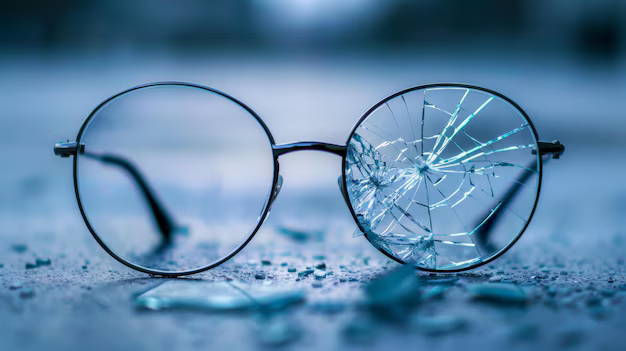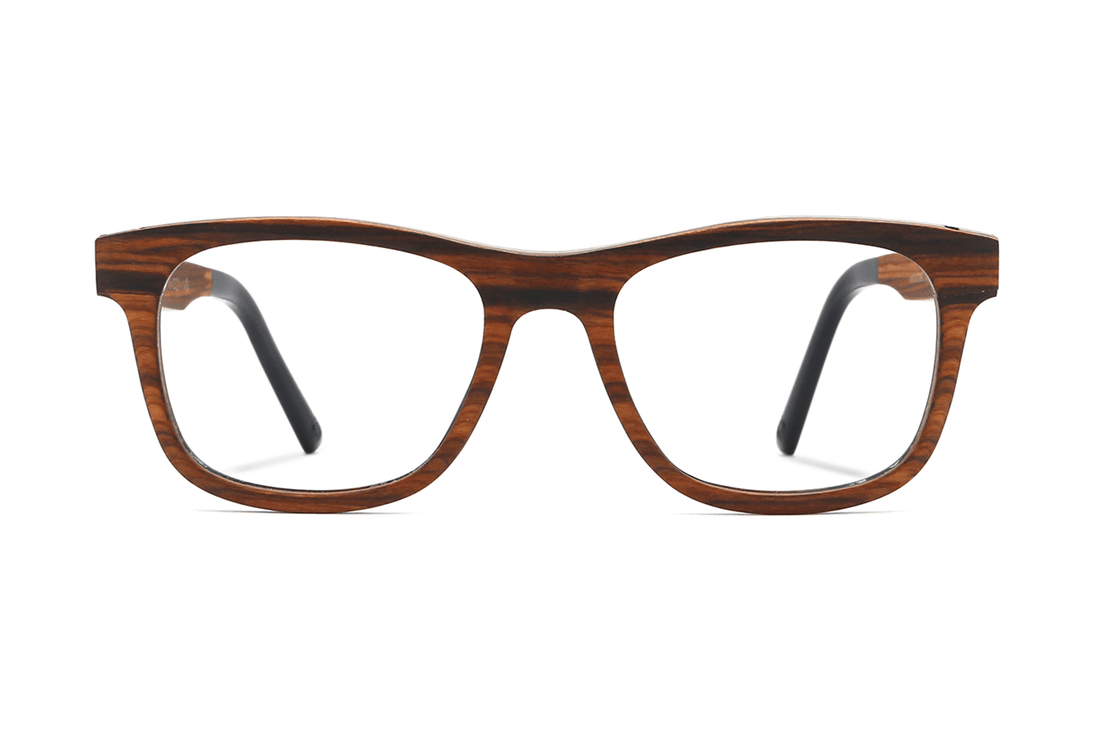
How to Fix Cracked Glasses Lens: Quick DIY Solutions
How to Fix Cracked Glasses Lens
8 min read • Posted on 25 November 2024
If the cracked glasses lens splinter throws you into a panic because you can’t pay the opticians to fix it for a week or more, don’t worry: there are some significant DIY fixes you can do in an afternoon to help you see yourself out of this sticky situation.
Learning how to fix cracked glass lenses can save time and money and prevent you from throwing away your plastic glasses frames long before their time. Believe it or not, you can do some good for your specs if the lens starts to crack.
While these home remedies can be helpful as a quick way to ease your stress, there’s always a risk involved when dealing with cracked lenses: leaving the problem as it is and forgetting all about it is never a good idea. Over time, the crack can spread further to reach the nose pads or the glasses hinges, so the safest option is always to handle cracked lenses carefully.
Let’s examine five easy and safe DIY steps for Fixing broken glasses, lenses, and metal glasses frames at home. Try these tips to save money and time.
DIY Methods for Fixing Cracked Lenses
Toothpaste and baking soda method
To reduce the visibility of cracks in your lenses, make a mixture of toothpaste and baking soda made from mild abrasives, which can polish away small cracks. Mix up a palm-full of non-gel toothpaste with baking soda until it forms a paste, then apply it to the crack with a soft cloth in a slow, circular motion. Finally, add water to rinse it out. This will only be somewhat effective.
The crack is still there. A toothpaste polish will not make it miraculously disappear. That’s a costly repair. But it will shore up the edges, taking the shine off the cracks and leaving your scratched lenses looking smoother than bent metal frames.
The DIY hack is quick and easy and requires only commonly available household materials. But remember that the hack is just that; it’s not a fix. It works best with shallow scratches, not deep cracks. Using it more than once appears likely to cause additional lens damage, so use it only as a (somewhat) cheap last-resort trick.
Using scratch repair kits on broken glasses
Another low-cost option is a do-it-yourself solution in the form of lens scratch repair kits. These over-the-counter products usually contain a straightforward solution that can flow into a lens scratch and even out the lens surface.
This solution might be suitable in a pinch and can be picked up in any local drugstore, usually for under $20. These scratch-fixing materials will work best for minor scuffs but are primarily ineffective on significant cracks. Again, they can reduce the appearance of a crack, but you may remain unhappy with the results afterward.
While relatively easy to do and buy, scratch repair kits have their own issues. If you have lenses made of more exotic materials or special coatings applied to them, chances are they won’t be effective. Suppose you misuse them, such as by using too many solutions.
In that case, you may worsen the crack or cause the solution to evaporate before it can do its job, resulting in a cloudy lens (definitely not something to cross your eyeball with). In short, try them out if you’ve got a scratch on the surface that you think is minor, but don’t expect them to be particularly effective on a significant crack.
Temporary fixes with clear nail polish for metal frames
Clear nail polish is a speedy and cheap way to ‘temporarily’ keep a crack from widening. I say ‘temporarily’ only because this technique keeps the damaged lenses intact but doesn’t save you any money in the long run since you’ll have to replace the glasses once the adhesion wears off and you see some of the wobbly, smiley rings.
I’ve also used nail polish on bent frames with tiny cracks between screw holes. You take a bit of polish and run it along the length of the fissure until it dries. It’s like super glue to the cracks, mending the two edges and keeping them apart. It’s an easy and inexpensive fix in a pinch. After all, sometimes you’ve just got to make the best of a situation where you can’t immediately replace your eyeballs.
However, remember that nail polish is not intended for use as an optical surface coating, so it is likely to leave a smudgy residue or cloud the lenses enough to blunt the sharpness of your vision.
Wear it as thin a layer over scratched glasses lenses as possible, and don’t coat the entire lens. This won’t bring back your lenses to their former glory, but it will buy you time and delay the need for a more permanent fix.
Professional Repair vs. DIY Fixes
When to opt for professional help
While DIY can be helpful in the short term, it might not result in something as robust or as straightforward as you’d like it to be for everyday wear. DIY can also leave you with cracks in the sides of a lens.
Professional repair will provide greater certainty when there are significant cracks near the center of your line of sight or when you have high-quality lenses with special coatings. Opticians often have materials and tools designed to be a little more suitable for repairing cracks, and they might also be better able to keep it safe for longer.
So, do what to do: choose professional repair before your glasses are on their last leg, or you’re forced to move on to another temporary fix. If your lenses have deep, complicated cracks or if they happen to be expensive lenses you want to save, you should probably entrust them to professionals anyway, who might have a better idea for you of salvaging the lenses with side mounts or could even try to see if you can replace just the lenses on glasses you’re still happy with.
Cost of professional glasses lenses repair
The cost of professional glasses repair can depend on the extent of the damage; a simple minor scratch could cost around $20-$40, with much more severe cases of cracks from falling glasses costing between $50-$100 or more, especially if you have anti-glare or blue-light filters on your glasses. A professional repair will likely be the most effective way to save your lenses, even if it costs more.
Knowing the potential costs will help you decide whether it’s worth opting for a professional repair. Though you might wonder about the high prices, your optician usually offers a warranty or guarantee.
The risks of DIY repairs
But DIY fixing is also a gamble: while it might seem satisfying to pop a cork here or use some gaffa tape there, ‘home remedy’ can be counterproductive in that damage may accumulate over time, especially if any substance containing toothpaste, polish, or other greasy residue or scratches is left on the lenses.
Even if there’s no damage from the materials, repeating the DIY exercise can compromise the optical quality of the lenses, potentially causing blurred vision or eyestrain.
Subpar repairs might even forfeit any warranties your lenses or frames might have held, meaning higher repair costs in the future. And lastly, think about the kind of lenses and broken metal frames you have and their significance to the everyday functioning of your life.
Suppose you weigh the risk-benefit of DIY solutions. In that case, you might be tolerant of a quick patch for a critical prescription lens to make it to the following weekend until you can afford a professional and thorough repair service.
Preventing Future Lens Damage
Proper care and cleaning of lenses
Avoid shortening. Keep your helpful life short by paying attention to your glass's basic cleaning and care habits. Use a soft microfiber cloth and cleaner made for eyeglasses to keep your lenses scratch and streak-free.
Do not clean your lenses by wiping them with clothing or tissues (which can scratch your lens and rim or create other micro-abrasions that weaken the lens over time). Clean your glasses regularly and gently, and do not spray or rub them with solutions or cleaners around the home.
Consistent, gentle cleaning can minimize the likelihood of cracks and scratches. While it might seem like a small effort daily, a little more maintenance time will save you money on repair or replacement bills later on. Even minor changes to your management habits, such as using the correct cleaning aids, can make an enormous difference.
Best storage practices
One of the easiest ways to avoid damage to your lenses is to store them properly. Keeping your glasses in a hard case when you’re not wearing them will reduce your chances of accidental damage as they are far less likely to be dropped or scratched with a hard surface case. Lenses should not be left face down on any surface and should be kept away from excessively hot or cold temperatures, which may weaken the lens material.
Good storage habits can prolong the life of your lenses and frames. Keep a case with you in various locations, such as your car or the office, just in case you don't have one. Simple tweaks to avoid scratching your lenses and damaging your frames can help you see clearly and comfortably for longer without needing replacement.
Upgrading to more durable lenses
If you regularly break or scratch your lenses, choose more durable lenses. Polycarbonate or Trivex is an impact-resistant alternative to glass. These lenses break less efficiently and will bend and twist to prevent shattering if a flying ball makes contact. An anti-scratch coating will help any lenses dodge some of the future damage they will see.
While the upfront cost might be more significant, long-term savings through reduced repair costs and an extended lifetime of your eyewear will ensure you make a wise investment. Impact-resistant lenses are a practical, economical alternative for those who love to play hard or work in more demanding environments.
What to Do When Cracks Worsen
Identifying unsafe cracks
Not all cracks are created equal, however. Some are cosmetic, while others are dangerous because they impair safety and vision. Dangerous cracks are deep, within your usable field of vision, or spidering out from the center.
These cracks impair clarity and can create a hazardous situation. If cracks in your glass obscure your vision or their existence is made apparent by rim vibration that you cannot ignore, then it’s time to entertain other options.
That means knowing when a crack becomes an itch, such as if squinting or turning your head to avoid a crack causes eye strain or a safety risk, and your lenses might need to be checked out by a professional.
Replacement options
Unless your lens crack is too far gone for repair, replace only the lenses. Keep your frames if they’re still in decent condition. This is usually cheaper than another complete pair; most optical providers will replace lenses for you. If your plastic frames are also Route 66, a new pair might be your best option.
Exploring your replacement options can help you find the most affordable and practical route to your desired vision. For your best vision and lifestyle, a replacement can offer a new chapter and pair of lenses without racking up hundreds or even thousands of dollars in new spectacles.
Optical retailers often provide a specific discount for returning customers or other packages that make lens replacement more affordable.
Warranty and insurance coverage
Is this a repair or a replacement? Call the manufacturer, check your paperwork, or ask them to verify whether the glasses are covered by warranty or insurance. Many eyeglass warranties cover the cost of the glasses frame and lenses for a limited timeframe, and some vision insurance plans will pay part of the replacement costs. This can be particularly useful for expensive lenses or designer frames.
Lower repair costs via insurance and warranty coverage. Consider the cost-effectiveness of service contracts or insurance plans: if your device breaks down or has to be replaced, you must pay for it anyway, even if you require frequent repairs and services.
Contact your provider and determine whether your plan covers any cost aspect. Insurance or a service plan can save money and make the process less stressful.
Alternative Solutions for Glasses Wearers
Backup pairs and lens protection
If you damage your glasses unexpectedly, a spare pair can be a sight saver. A spare pair makes life much easier if your glasses break or need repair, limiting discomfort. Also, consider adding protective extras such as anti-scratch coatings or lens protectors to both pairs to help minimize the risk of damage.
The reassurance of a backup pair of prescription glasses or particular accessories that shield the lenses is all added insurance that takes the sting out of unexpected damage. They represent an additional investment in convenience that ensures that your boating day won’t end with a visit to the port house because you can’t see where you are going.
Contact lenses as a temporary solution
If your glasses need to be fixed, you may be tempted to use contact lenses, at least temporarily; they're convenient and allow you to keep clear vision while your lenses are being repaired. However, it is best to use disposable lenses that you can throw away after each use without the obligation of maintaining them in the long term.
More importantly, but again, as a bonus, with this option, you can make the repairs to your glasses conveniently, even without changing your schedule if you are busy. With metal glasses frames and contact lenses, you can go about your business as usual and go into clear vision as if you are being fitted with glasses for the first time.
Repair services you can use
For quick and trusted glass repair, there are various specialized services you can opt for. Some opticians offer in-house maintenance. You could try services specializing in eyeglass repair, which are gaining immense popularity online for their assessment, price estimate, and turnaround time.
Instead, it would help if you always had your lenses fixed through an accredited repair service to get the best quality and attention they deserve. Depending on how you break your lenses, various lens repair options ensure you are in safe hands. Whether you need a quick fix or a complete restoration, top-notch experts will care for your lenses without a headache.
Say your glasses lens suddenly develops a crack in the middle of the woods, far from a shop selling a cheap replacement. In a pinch, anywhere you can find toothpaste, you’ll also find a tarp, bicycle chain, glue, and a way to put some tuna together.
In the case of a broken glasses hinge, a DIY solution certainly helps to reduce the visibility of a crack and might tide you over for an hour until it doesn’t. If you know you are prone to breaking your glasses, give yourself some wiggle room: buy easily replaced ones. But if this isn’t your third pair in a week and they are relatively new, your best bet is to seek a professional optician.
Ultimately, knowing how to repair a glasses lens with a crack gives you the autonomy to try home solutions first, saving a trip to the expert care you deserve. It would help if you always paid attention to the well-being of your most precious sense.
 Heba Ahmed
Heba Ahmed














